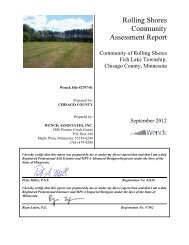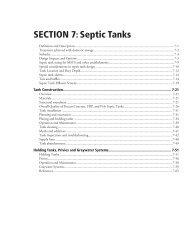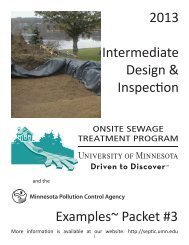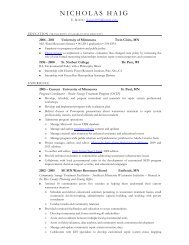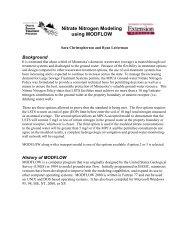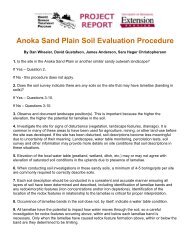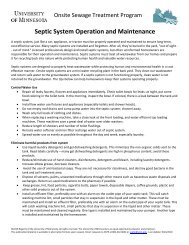MPCA Design Guidance for Large Subsurface Wastewater ...
MPCA Design Guidance for Large Subsurface Wastewater ...
MPCA Design Guidance for Large Subsurface Wastewater ...
Create successful ePaper yourself
Turn your PDF publications into a flip-book with our unique Google optimized e-Paper software.
To arrive at the most successful system design, the designer must consider the following factors:<br />
• waste strength treatment devices<br />
• nutrient treatment devices<br />
• fecal reduction devices<br />
• soil dispersal system<br />
o<br />
o<br />
o<br />
sizing<br />
geometry<br />
dosing frequency<br />
• natural soil treatment capabilities<br />
• dilution<br />
• operation and maintenance requirements<br />
11. Septic tank sizing and design considerations (complete Attachment 11)<br />
Now that the drainfield size and shape have been determined and the location and treatment<br />
effectiveness have been proven, the designer is ready to design the rest of the subsurface wastewater<br />
system.<br />
The first step in this process involves appropriate sizing of septic tanks. LSTS designers have the option<br />
of designing either individual septic tanks or community septic tank systems. Thus, there will either a<br />
small (e.g. 1,500-gallon) septic tank at each house or a series of large septic tanks at one central location.<br />
Having a tank at each house and then pumping the septic tank effluent to a common treatment system is<br />
referred to as a STEP system (septic tank effluent pump) system. To size individual septic tanks <strong>for</strong> a<br />
STEP system, refer to Minnesota Rule 7080.0130. For the sizing of community septic tank systems,<br />
follow the sizing protocol below.<br />
If a STEP system is utilized, agreements have to be made as to whose responsibility it is to maintain and<br />
pump the tanks (either the individual home owner or the wastewater operator <strong>for</strong> the treatment system).<br />
There is a third option that could be considered: instead of installing septic tanks in which solids settle<br />
out and accumulate, the designer may consider installing a wastewater clarifier with a continuous solidsremoval<br />
system. Because capacity <strong>for</strong> solids accumulation is no longer needed with a clarifier, one can<br />
often build smaller primary treatment units than if septic tanks were to be installed. Note, however, that<br />
clarifiers have mechanical moving parts. This may offset any savings. Also, one has to decide whether<br />
the wastewater system should look more like a mechanical wastewater plant or a large-scale septic<br />
system. Either system works, but it is the designer’s decision as to what will work best <strong>for</strong> the situation<br />
at hand.<br />
Septic tank sizing determination<br />
Septic tanks are designed <strong>for</strong> the removal of suspended solids, carbonaceous biochemical oxygen<br />
demand (CBOD), heavy metals, nutrients, and some pathogenic organisms. For normal, domesticstrength<br />
wastewater, properly designed septic tanks can provide discharge concentrations of 220 mg/L<br />
or less CBOD, 65 mg/L or less total suspended solids, and 30 mg/L or less fats, oil and grease. Note that<br />
the main design concern <strong>for</strong> septic tank sizing should be to assure the effluent exiting the last septic tank<br />
and entering the secondary-treatment device (if applicable) is within the design CBOD and TSS loading<br />
rates <strong>for</strong> that secondary treatment unit. If no secondary treatment unit is employed and the soil treatment<br />
unit is instead the secondary treatment unit, the soil treatment unit needs to be sized to accommodate the<br />
CBOD/TSS loading exiting the last septic tank.<br />
Septic tank sizing is based on the peak design flows which ensures an adequate retention time during<br />
high-flow conditions. Additional volume above the minimum required volume will provide additional<br />
solids-settling capacity and will minimize downstream impacts from variable flows.<br />
<strong>Design</strong> <strong>Guidance</strong> <strong>for</strong> <strong>Large</strong> <strong>Subsurface</strong><br />
Minnesota Pollution Control Agency<br />
<strong>Wastewater</strong> Treatment Systems April 2010<br />
21




